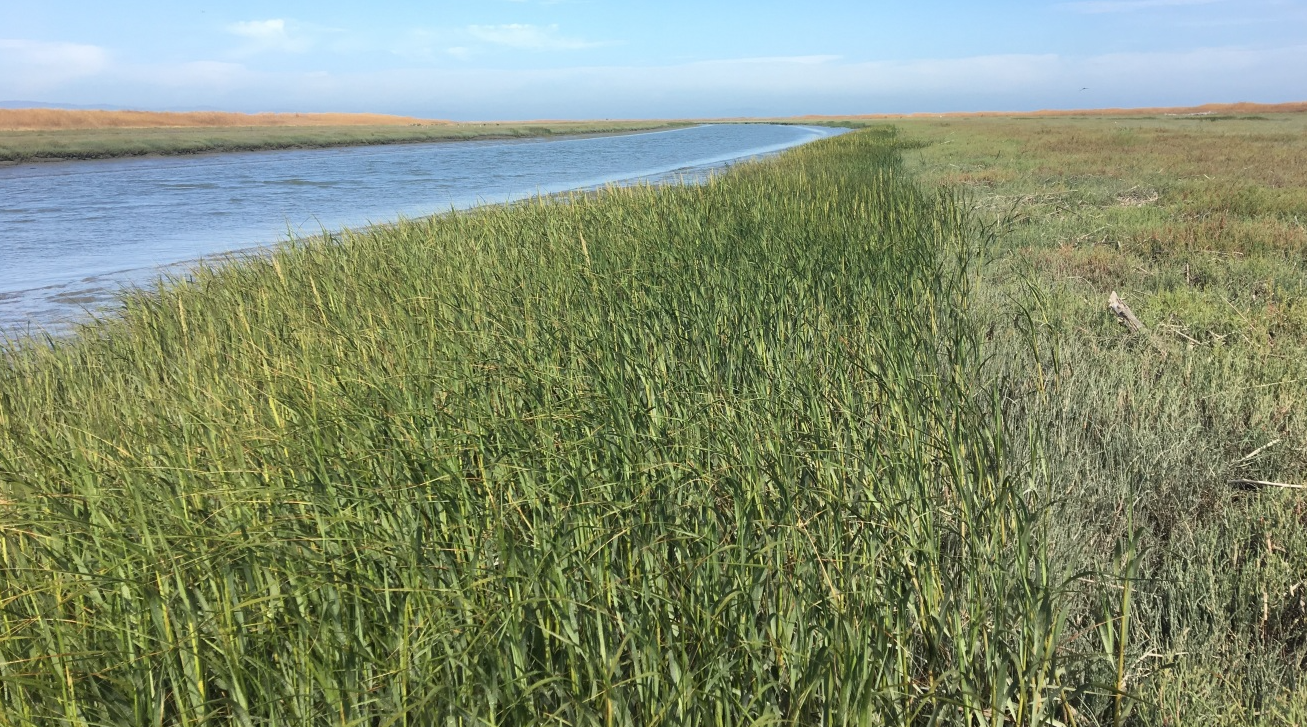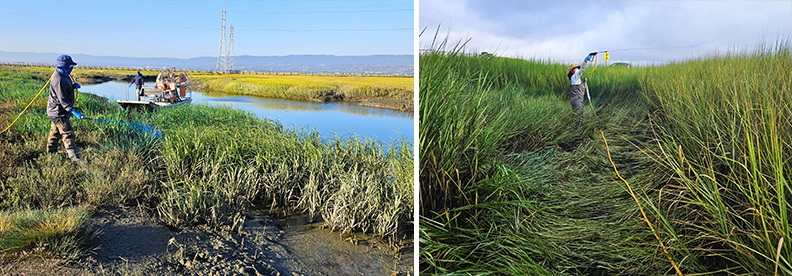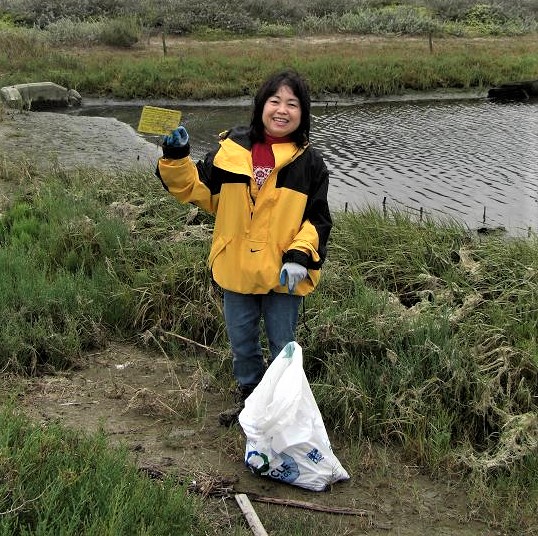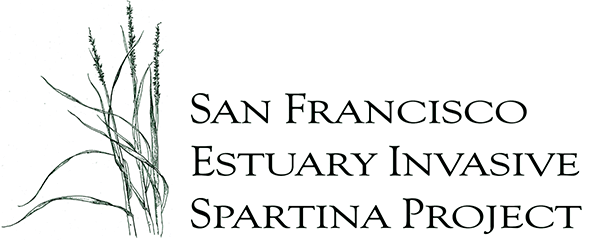
The San Francisco Estuary Invasive Spartina Project (ISP) works toward the eradication of invasive Spartina (cordgrass), protecting native tidal marshes and mudflats across the 70,000-acre project area in San Francisco Bay.
The ISP has reduced the net area of invasive Spartina by more than 97%, from a peak of 805 net acres in 2005 down to 20.7 net acres as of 2022 monitoring. However, at a subset of sites, treatment has proceeded slowly in a carefully phased approach to protect the endangered California Ridgway’s rail (Rallus obsoletus obsoletus).
After interagency consultations with U.S. Fish and Wildlife Service in 2018, and annual Ridgway’s rail monitoring from 2010-2017 had confirmed stable population trends around the Estuary, the ISP was permitted to begin phase one treatment at ten out of sixteen sites that had previously been restricted to help reduce impacts to rails. The Coastal Conservancy received its 2023-2033 Biological Opinion for the ISP just before the start of this 2023 field season, which approved phase two treatment at an additional six sites (Fan Marsh Main, Arrowhead Marsh East, MLK New Marsh, North Marsh, Citation Marsh Central, Cogswell B Main) that had been restricted since 2011. Treatment will be initiated at these sites over several years, pending monitoring feedback loops to ensure a careful, protective approach for the benefit of Ridgway’s rail.
Thank you to all partners for your dedication and involvement in this critical and ongoing work!
Treatment:
Another busy ISP treatment season has drawn to a close. The ISP team succeeded in resuming treatment at three of six sites that were permitted to begin in 2023 (as discussed above in the Biological Opinion update). Thanks to years of experienced partnership with the on-the-ground contractors, and the efficient use of technologies that were not available to the project in the early years, the treatment crews far exceeded expectations of what we might be able to accomplish in the first year of full treatment at these sites. Two of these sites, Cogswell Marsh B Main in Hayward Regional Shoreline and Fan Marsh Main in San Leandro Bay, were large monocultures of hybrid Spartina that were fully treated this season in partnership with East Bay Regional Park District. Approximately 85% of the third site, Citation Marsh Central in Roberts Landing, was also treated in 2023 in partnership with the City of San Leandro. These three sites contained 24% of the remaining hybrid Spartina in the entire Estuary prior to conducting treatment in 2023, so this phased treatment is a huge step forward towards reducing the remaining invasive Spartina in the Bay.
In addition to the enormous task of adding three new heavily-invaded treatment sites to the annual work program, extra effort was made this year to address the increase in hybrid Spartina growth that often occurs in years with high rainfall. Despite being wetland plants that have evolved to thrive in the harsh tidal marsh environment, both native and invasive Spartina benefit from above-average rainfall. Fresh water may increase sprouting from the seed bank, as well as any rhizome fragments not fully eliminated by prior treatment. With the rapid pace at which the hybrid grows, the greater freshwater input in high rain years can quickly increase the infestation of invasive Spartina at a given site.

Restoration:
Throughout the year, the restoration team monitored previous plantings at more than thirty sites across the region, including Cogswell Marsh (pictured below) along the Hayward Regional Shoreline. The team recorded high survivorship in planted species, and was thrilled to see planted marsh gumplant, marsh baccharis, and other natives successfully root, spread, and rebuild habitat. The team’s strategy to effectively crowd out weeds involved planting high-density clusters of a single native species in each plot. This allowed maintenance teams to return and pull weeds around the edges with minimal disturbance to the restored habitat. With these lessons in mind, the winter planting season is now underway, and will continue through early spring.

Ridgway’s Rail Monitoring:
Protected tidal marshes provide critical habitat for sensitive species, including the endangered California Ridgway’s rail. Monitoring teams have completed the 2023 Ridgway’s rail report and are now preparing for the 2024 survey season, which occurs January – April. Preliminary analysis of the 2023 results show that the population is stable from the previous year. Find the 2022 Ridgway’s rail report online here.
Drift Card Study:
Before the 2023 field season kicked into high gear, the ISP completed a report on its Drift Card Study, conducted between 2007 and 2012. The marshes of the Estuary are part of an open aquatic system connected by twice-daily tidal exchange capable of dispersing both native and non-native plant seeds and rhizomes between and within marshes. To increase the project team’s understanding of dispersal patterns within the Estuary and help predict where to survey for potential new infestations, the ISP released 3,000 floating wooden drift cards in three rounds over the six-year study period.
The Drift Card Study demonstrated the interconnectedness of the Estuary, engaged stakeholders throughout the project area, and involved them in the tidal marsh and mudflat resource conservation work of the ISP, Coastal Conservancy, U.S. Fish and Wildlife Service, and other partners. The study recorded dispersal distances in a range of 2-42 miles within the Estuary, and distances of up to 60-80 miles to the outer coast, after passing through the Golden Gate. Cards were reported from as far north as the mouth of the Russian River, and as far south as Bean Hollow and Pescadero State Beach.

Outreach:
On September 19, Restoration Program Manager Jeanne Hammond gave a presentation at the San Francisco Estuary Partnership Wetland Migration Workshop (talk starts at 42:09). Her talk focuses on the goal of enhancing restored marsh-upland transition zones, and shares lessons learned.
On October 27, ISP Program Treatment Manager Drew Kerr gave a presentation at the 2023 Cal-IPC Symposium on Regional partnerships to steward San Francisco Bay wetlands. Drew also presented on November 30 at the Delta Invasive Species Symposium in Sacramento (talk starts at 54:36).
Thank you!
Thanks to the wide range of collaborating organizations that make this work possible including: State Coastal Conservancy, US Fish and Wildlife Service, East Bay Regional Park District, California Dept. of Fish and Wildlife, Port of Oakland, SF Bay Joint Venture, California Invasive Plant Council (Cal-IPC), Olofson Environmental, Inc., San Francisco Bay Restoration Authority, Valley Water, and more than 150 project landowners, partners, and contractors. Together, we are working together to protect the Bay’s shorelines.
